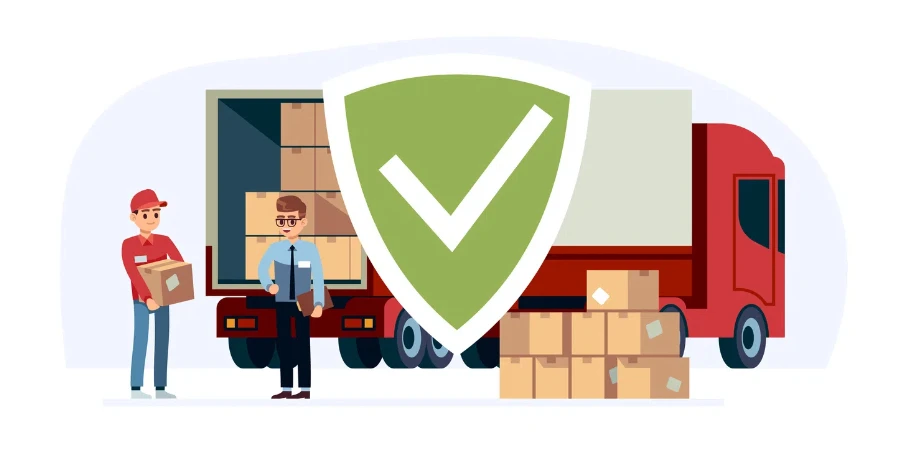Handling requirements and certifications for ecommerce brands shipping dangerous goods (DG) is a critical aspect of ensuring safety, compliance, and customer satisfaction. With the increasing popularity of ecommerce, the transportation of hazardous materials has become more prevalent, necessitating stringent regulations and careful management.
Whether you ship the products yourself or outsource fulfillment and logistics to a third-party logistics provider, your business is responsible for following all rules and regulations associated with handling and shipping, any mislabeling or incorrect handling of DG goods can result in fines or worse.
Here are the requirements to properly handle, fulfill, and ship dangerous goods items.
Examples of Ecommerce Products Considered Dangerous Goods (DG)
What are the Classes of Dangerous Goods?
There are many various types of dangerous goods. To be properly labeled they must first be categorized into a hazard class, this information should be included on a safety data sheet (SDS) provided by the manufactuer.
Each of these classes of dangerous substances and hazardous materials determine the specific training requirements, shipping labels, and storage areas to handle them correctly and ensure safe transport.
- Class 1 Explosives
- Class 2 Gases and Flammable Gases
- Class 3 Flammable Liquid and Combustible Liquid
- Class 4 Flammable Solid, Spontanaeously Combustible and Dangerous When Wet
- Class 5 Oxidizer and Organic Peroxide
- Class 6 Poison (Toxic Substances) and Poison Inhalation Hazard
- Class 7 Radioactive Materials
- Class 8 Corrosive
- Class 9 Miscellaneous
Types of Products Considered Dangerous Goods
Lithium-ion Batteries: Items such as smartphones, laptops, power banks, and electronic devices containing lithium-ion batteries are classified as dangerous goods due to their potential fire and explosion hazards.
Perfumes and Fragrances: Perfumes, colognes, and other fragrances often contain flammable substances, making them hazardous for transportation.
Aerosol Products: Spray paints, hairsprays, deodorants, and other aerosol products are considered dangerous goods due to their pressurized containers and flammable contents.
Cleaning Chemicals: Household cleaning products, including bleach, ammonia, and other chemicals, can be hazardous due to their corrosive or toxic properties.
Paints and Solvents: Paints, varnishes, and solvents contain volatile organic compounds (VOCs) and may be flammable, making them hazardous for shipping.
Pesticides and Insecticides: Products used for pest control, such as insecticides, herbicides, and rodenticides, contain chemicals that are harmful to humans and the environment.
Medical Supplies: Certain medical supplies, such as adhesives, disinfectants, and pharmaceuticals, may be considered hazardous due to their chemical composition or potential for misuse.
Electronic Waste (e-waste): Discarded electronic devices, components, and batteries contain hazardous materials such as lead, mercury, and cadmium, which pose environmental and health risks if not properly handled and disposed of.
Flammable Liquids: Products such as fuels, oils, and certain cosmetics contain flammable liquids and are classified as dangerous goods due to their fire hazard.
Sharp Objects: Items like knives, blades, and other sharp objects are considered dangerous goods due to the risk of injury during handling and transportation.
Top Six Requirements to Correctly Handling and Packaging Dangerous Goods (DG)
It’s essential for ecommerce brands to understand the regulatory landscape governing the transportation of dangerous goods. Regulations vary depending on the nature of the goods being shipped, the mode of transportation, and the destination. For example, in the US Department of Transportation (DOT) regulates the transportation of hazardous materials through its Hazardous Materials Regulations (HMR). Similarly, international shipments must comply with the regulations set forth by organizations such as the International Air Transport Association (IATA) and the International Maritime Dangerous Goods (IMDG) Code.
1. Labor and Training
Before you can start shipping any DG items, it’s imperative to obtain the necessary certifications and training for personnel involved in the handling and transportation process. This includes training on proper packaging, labeling, documentation, and emergency response procedures. Certifications such as DOT Hazmat training and IATA Dangerous Goods Regulations (DGR) certification are commonly required to ensure compliance with regulatory standards.
2. Packaging
Proper packaging essential for ensuring hazardous materials travel safely during shipping to minimize the risk of accidents or leaks. Packaging requirements are often specified based on the classification of the hazardous material, with different packaging standards for categories such as flammable liquids, corrosive substances, and toxic materials.
Technical instructions should accompany each product classified as DG on any assembly line, pick and pack station, or fulfillment line. Some warehouse workers might need to wear protective equipment when packing DG items.
3. Labeling and Documentation
Correct documentation of your specific items plays a vital role in ensuring the safe transportation of dangerous goods. Because there are many types of DG items, understanding the stringent requirements is important.
Ecommerce brands must accurately label packages containing hazardous materials with appropriate hazard symbols, warnings, and handling instructions. The shipper is responsible for supplying all correct documentation, including shipping manifests, material safety data sheets (MSDS), and emergency response information, must accompany shipments to provide essential information to carriers and regulatory authorities. This applies to domestic shipping and international shipping just the same.
4. Quality Control Checks
Regular audits and inspections are essential for ensuring ongoing compliance with handling requirements and certifications for ecommerce brands shipping dangerous goods. Internal audits can help identify any deficiencies or areas for improvement in the handling and transportation process, while external inspections by regulatory authorities or third-party auditors can verify compliance with applicable regulations and standards.
Employing a quality control team will help your warehouse and operations team resolve any issues quickly and ensure they don’t happen again.
5. Automation, WMS, and Operational Flow
A warehouse needs to be able to handle a variety of special packaging needs for the many different types of packages that they move through. If your warehouse ships DG items, all fulfillment and processing automation machines need to set up to support the needs of your products. Any automated label machines or print and apply machines need to be able to support the specific DG labels.
Another consideration is the warehouse management system (WMS) which needs to be set up to properly identify and manage the needs of any Dangerous Goods items through the order fulfillment process. There is a hierarchy of DG items and corresponding labels that need to be placed. For example, metal batteries are more dangerous when shipping, these products need a specific label that trumps any labels for other DG goods like lithium-ion batteries. Your WMS needs to ensure this specificity can be automated across your order fulfillment flow.
This is especially important for companies putting together product bundles or adding accessories that may change the labeling requirements for packages. Your WMS needs to be able to set rules to make sure these changes are put in place perfectly every time.
6. Carrier and Shipping Service
The transport of dangerous goods is a highly regulated area. One of the most important aspects of shipping DG items is selecting the right carrier and shipping service that supports DG. Carriers must have the necessary permits, licenses, and insurance coverage to transport hazardous materials, and they should adhere to strict safety protocols throughout the transportation process.
What Certifications are Required to Handle DG Products and Hazardous Materials
Certifications required for a warehouse to process dangerous goods and hazmat items vary depending on factors such as the type of hazardous materials handled, the regulatory jurisdiction, and the specific operations of the warehouse. However, some common certifications and qualifications include:
- Hazmat/Dangerous Goods Training Certification: Warehouse personnel involved in handling, storing, or transporting hazardous materials should undergo comprehensive training on the safe handling and storage of dangerous goods. Certifications such as DOT Hazmat training in the United States or IATA Dangerous Goods Regulations (DGR) certification for air transport are often required to ensure compliance with regulatory standards.
- OSHA Hazmat Operations Certification: The Occupational Safety and Health Administration (OSHA) in the United States sets standards for handling hazardous materials in the workplace. Warehouse personnel may need to obtain OSHA Hazmat Operations certification, which demonstrates proficiency in responding to hazardous materials incidents, including containment, cleanup, and emergency response procedures.
- HAZWOPER Certification: The Hazardous Waste Operations and Emergency Response (HAZWOPER) certification is required for personnel who are involved in the cleanup, treatment, storage, and disposal of hazardous waste. While not specific to warehouse operations, HAZWOPER certification may be necessary for warehouses that handle hazardous waste materials in addition to dangerous goods.
- Forklift Operator Certification: Warehouses often use forklifts and other material handling equipment to move and store hazardous materials. Forklift operators should undergo training and certification to ensure safe operation and prevent accidents or spills involving dangerous goods.
- Fire Safety and Prevention Training: Warehouses that handle hazardous materials should have fire safety measures in place to prevent and respond to fire incidents effectively. Personnel may need training and certification in fire prevention, extinguisher use, and emergency evacuation procedures.
- Environmental Management System (EMS) Certification: Some warehouses may choose to implement an Environmental Management System (EMS) to manage environmental risks associated with handling hazardous materials. Certification to standards such as ISO 14001 demonstrates compliance with environmental management best practices.
- Security Clearance: Depending on the nature of the hazardous materials handled, warehouses may need to comply with security regulations and obtain security clearances or certifications to prevent unauthorized access or tampering with dangerous goods.
- Customs Trade Partnership Against Terrorism (C-TPAT) Certification: For warehouses involved in international trade, C-TPAT certification enhances security measures throughout the supply chain to prevent the introduction of terrorist weapons or contraband into the shipment process. While not specific to hazardous materials, C-TPAT certification may be relevant for warehouses handling dangerous goods in international trade.
Bottom Line
It’s essential for ecommerce retailers to properly identify, label, package, and handle any products classified as dangerous goods in accordance with regulatory requirements to ensure the safety of workers, carriers, and end consumers. If you are unsure how to do this on your own, work with a 3PL or fulfillment provider with extensive experience handling consumer electronics, health and beauty products, and other DG items.
Source from DCL Logistics
Disclaimer: The information set forth above is provided by dclcorp.com independently of Alibaba.com. Alibaba.com makes no representation and warranties as to the quality and reliability of the seller and products.




